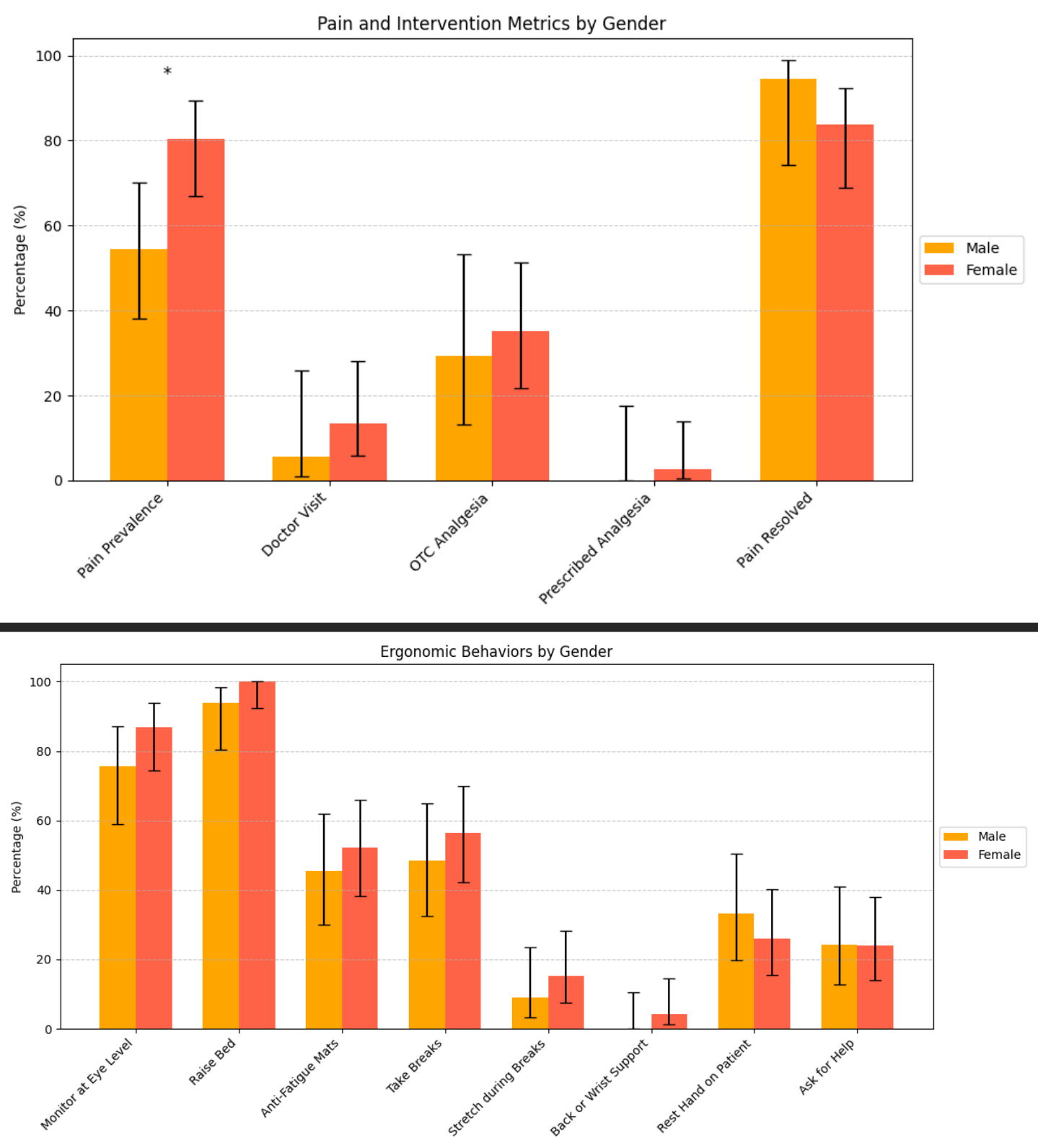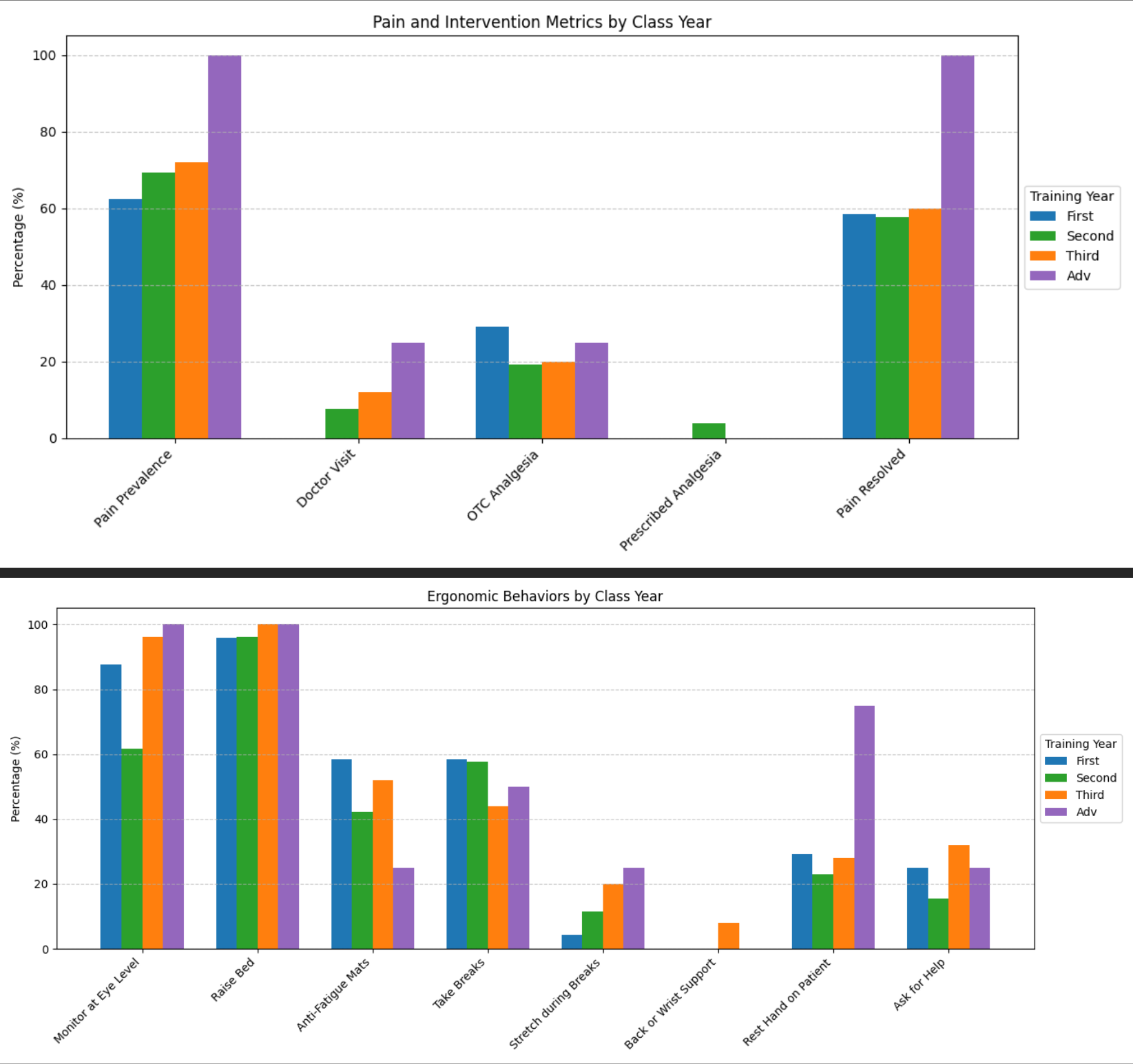Tuesday Poster Session
Category: General Endoscopy
P5140 - Ergonomics in Endoscopy: A National Survey of Gastroenterology Fellows on Endoscopy-Related Musculoskeletal Pain and Ergonomic Behaviors
Tuesday, October 28, 2025
10:30 AM - 4:00 PM PDT
Location: Exhibit Hall

Srikaran Bojja, MBBS, MD (he/him/his)
Geisinger Wyoming Valley Medical Center
Wilkes Barre, PA
Presenting Author(s)
Srikaran Bojja, MBBS, MD1, Michael Bebawy, DO2, Anusha Kavarthapu, MD3, Abeer Qasim, MD4, Danial H.. Shaikh, MD5, Ahmed Al-Khazraji, MD2
1Geisinger Wyoming Valley Medical Center, Harrison, NJ; 2Rutgers New Jersey Medical School, Newark, NJ; 3SUNY Downstate Medical Center, Staten Island, NY; 4BronxCare Health System, Bronx, NY; 5Geisinger Health System, Danville, PA
Introduction: Endoscopic procedures are a core component of gastroenterology fellowship training, yet they pose a significant and well-documented risk for endoscopy-related injuries (ERIs). Although the American Society for Gastrointestinal Endoscopy (ASGE) published guidelines on ergonomics in endoscopy in 2023, limited data exist regarding the prevalence of ERIs among fellows and the ergonomic practices or coping strategies employed. This study investigates the prevalence of endoscopy-related musculoskeletal pain, associated coping strategies, ergonomic practices, and ergonomic training among U.S. gastroenterology fellows.
Methods: A national survey was distributed to gastroenterology fellows assessing procedural volume, musculoskeletal pain, pain management strategies, ergonomic behaviors, and whether fellows had received ergonomic education. Pain-coping strategies and ergonomic behaviors were stratified by gender and training level. Associations between ergonomic practices and pain were evaluated using chi-square testing and independent-sample t-tests.
Results: Seventy-nine fellows completed the survey, including 46 females (58.2%) and 33 males (41.8%), with balanced representation across training levels. Average daily procedure volume increased with training year (first year: 5.0; third year: 7.7; p = 0.004). Only 62.0% of fellows reported receiving ergonomics training, despite 89.9% agreeing on its importance. Pain prevalence increased by training level (62.5%, 69.2, 72.0%, and 100% for first through advanced fellows, respectively); however, ergonomic behaviors and pain-management strategies were similarly employed across training levels. When stratified by gender, female fellows reported significantly higher rates of musculoskeletal pain compared to males (males: 54.5%; females: 80.4%; p = 0.014), and more frequently adopted both pain-management strategies and ergonomic behaviors.
Discussion: Endoscopic-related musculoskeletal pain is common among gastroenterology fellows and increases with advancing fellowship training year. Many fellows lack formal ergonomic training, and key preventative strategies remain underutilized. The higher burden of musculoskeletal pain among female trainees highlights the need for tailored ergonomics interventions. These findings underscore the importance of incorporating formal, structured ergonomics education early in fellowship training to mitigate musculoskeletal pain and long-term injury risk.

Figure: Pain along with Intervention Metrics and Ergonomic behaviors by Gender

Figure: Pain along with Intervention Metrics and Ergonomic behaviors by Class year
Disclosures:
Srikaran Bojja indicated no relevant financial relationships.
Michael Bebawy indicated no relevant financial relationships.
Anusha Kavarthapu indicated no relevant financial relationships.
Abeer Qasim indicated no relevant financial relationships.
Danial Shaikh indicated no relevant financial relationships.
Ahmed Al-Khazraji indicated no relevant financial relationships.
Srikaran Bojja, MBBS, MD1, Michael Bebawy, DO2, Anusha Kavarthapu, MD3, Abeer Qasim, MD4, Danial H.. Shaikh, MD5, Ahmed Al-Khazraji, MD2. P5140 - Ergonomics in Endoscopy: A National Survey of Gastroenterology Fellows on Endoscopy-Related Musculoskeletal Pain and Ergonomic Behaviors, ACG 2025 Annual Scientific Meeting Abstracts. Phoenix, AZ: American College of Gastroenterology.
1Geisinger Wyoming Valley Medical Center, Harrison, NJ; 2Rutgers New Jersey Medical School, Newark, NJ; 3SUNY Downstate Medical Center, Staten Island, NY; 4BronxCare Health System, Bronx, NY; 5Geisinger Health System, Danville, PA
Introduction: Endoscopic procedures are a core component of gastroenterology fellowship training, yet they pose a significant and well-documented risk for endoscopy-related injuries (ERIs). Although the American Society for Gastrointestinal Endoscopy (ASGE) published guidelines on ergonomics in endoscopy in 2023, limited data exist regarding the prevalence of ERIs among fellows and the ergonomic practices or coping strategies employed. This study investigates the prevalence of endoscopy-related musculoskeletal pain, associated coping strategies, ergonomic practices, and ergonomic training among U.S. gastroenterology fellows.
Methods: A national survey was distributed to gastroenterology fellows assessing procedural volume, musculoskeletal pain, pain management strategies, ergonomic behaviors, and whether fellows had received ergonomic education. Pain-coping strategies and ergonomic behaviors were stratified by gender and training level. Associations between ergonomic practices and pain were evaluated using chi-square testing and independent-sample t-tests.
Results: Seventy-nine fellows completed the survey, including 46 females (58.2%) and 33 males (41.8%), with balanced representation across training levels. Average daily procedure volume increased with training year (first year: 5.0; third year: 7.7; p = 0.004). Only 62.0% of fellows reported receiving ergonomics training, despite 89.9% agreeing on its importance. Pain prevalence increased by training level (62.5%, 69.2, 72.0%, and 100% for first through advanced fellows, respectively); however, ergonomic behaviors and pain-management strategies were similarly employed across training levels. When stratified by gender, female fellows reported significantly higher rates of musculoskeletal pain compared to males (males: 54.5%; females: 80.4%; p = 0.014), and more frequently adopted both pain-management strategies and ergonomic behaviors.
Discussion: Endoscopic-related musculoskeletal pain is common among gastroenterology fellows and increases with advancing fellowship training year. Many fellows lack formal ergonomic training, and key preventative strategies remain underutilized. The higher burden of musculoskeletal pain among female trainees highlights the need for tailored ergonomics interventions. These findings underscore the importance of incorporating formal, structured ergonomics education early in fellowship training to mitigate musculoskeletal pain and long-term injury risk.

Figure: Pain along with Intervention Metrics and Ergonomic behaviors by Gender

Figure: Pain along with Intervention Metrics and Ergonomic behaviors by Class year
Disclosures:
Srikaran Bojja indicated no relevant financial relationships.
Michael Bebawy indicated no relevant financial relationships.
Anusha Kavarthapu indicated no relevant financial relationships.
Abeer Qasim indicated no relevant financial relationships.
Danial Shaikh indicated no relevant financial relationships.
Ahmed Al-Khazraji indicated no relevant financial relationships.
Srikaran Bojja, MBBS, MD1, Michael Bebawy, DO2, Anusha Kavarthapu, MD3, Abeer Qasim, MD4, Danial H.. Shaikh, MD5, Ahmed Al-Khazraji, MD2. P5140 - Ergonomics in Endoscopy: A National Survey of Gastroenterology Fellows on Endoscopy-Related Musculoskeletal Pain and Ergonomic Behaviors, ACG 2025 Annual Scientific Meeting Abstracts. Phoenix, AZ: American College of Gastroenterology.
